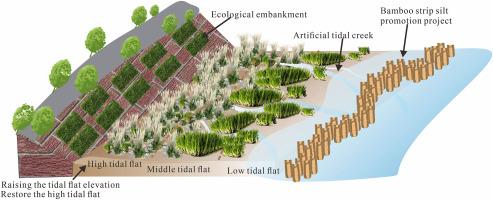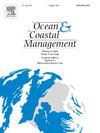巨型河流-潮汐河口潮坪可持续性的动态、脆弱性和适应策略
IF 5.4
2区 环境科学与生态学
Q1 OCEANOGRAPHY
引用次数: 0
摘要
河口滩涂是宝贵的自然资源,具有重要的生态、环境和经济效益。然而,激烈的人类活动正日益改变着潮滩的形态动力学,导致了河口潮滩的不可持续发展。此外,在为脆弱的沿海社区和生态系统制定有效的增强复原力战略方面仍存在知识差距。为此,本研究结合卫星影像、水深资料和水文资料,对2002 - 2023年长江河口4个主要潮滩的时空动态和风险进行了研究。结果表明:近20年来,崇明东部浅滩、横沙浅滩、九段浅滩和南会浅滩的盐沼扩展速率分别为3.13 km2/yr、6.44 km2/yr、3.58 km2/yr和5.56 km2/yr;然而,自2014年以来,九段浅滩裸滩的侵蚀速度明显,为2.45 km2/yr。长江东部潮滩的主要风险包括潮间带的丧失、地形的变陡、植被-无草区的不平衡扩张、潮沟的退化和互花米草的入侵。尽管河流沉积物在减少,但CJE的工程结构提高了潮滩的局部沉积速率,同时增加了未来不稳定的风险。因此,我们提出了有针对性的可持续滩涂恢复管理策略,优先考虑:1)泥沙补充途径;2)地貌修复技术;3)生态工程解决方案。这些基于证据的建议支持制定保护沿海生态系统可持续发展的政策。本文章由计算机程序翻译,如有差异,请以英文原文为准。

Dynamics, vulnerabilities, and adaptive strategies for tidal flat sustainability in a mega fluvial-tidal estuary
Estuarine tidal flats are valuable natural resources, offering significant ecological, environmental, and economic benefits. However, intense human activities are increasingly altering tidal flat morphodynamics, leading to the unsustainable development of estuarine tidal flats. Moreover, there remain knowledge gaps in developing efficient resilience-enhancing strategies for vulnerable coastal communities and ecosystems. Therefore, this study integrates satellite images, bathymetric data, and hydrological records to detect the spatiotemporal dynamics and risks of four major tidal flats in the mega-Changjiang Estuary (CJE) between 2002 and 2023. Our results indicated that four tidal flats prograded overall over the past two decades, with salt marsh expansion rates in the Eastern Chongming Shoal, Hengsha Shoal, Jiuduan Shoal, and Nanhui Shoal standing at 3.13 km2/yr, 6.44 km2/yr, 3.58 km2/yr, and 5.56 km2/yr, respectively. Nevertheless, the bare flat of Jiuduan Shoal experienced significant erosion at a rate of 2.45 km2/yr since 2014. The primary risks to tidal flats in the CJE include the loss of upper intertidal zones, steepening topography, imbalanced expansion of vegetated-unvegetated areas, degeneration of tidal creeks, and Spartina alterniflora invasion. Despite declining fluvial sediment, engineered structures in the CJE have enhanced local sedimentation rates in tidal flats while concurrently increasing future instability risks. We consequently propose targeted management strategies for sustainable tidal flat restorations, prioritizing: 1) sediment replenishment pathways, 2) geomorphic rehabilitation techniques, and 3) ecological engineering solutions. These evidence-based recommendations support policy development for preserving coastal ecosystems sustainable development.
求助全文
通过发布文献求助,成功后即可免费获取论文全文。
去求助
来源期刊

Ocean & Coastal Management
环境科学-海洋学
CiteScore
8.50
自引率
15.20%
发文量
321
审稿时长
60 days
期刊介绍:
Ocean & Coastal Management is the leading international journal dedicated to the study of all aspects of ocean and coastal management from the global to local levels.
We publish rigorously peer-reviewed manuscripts from all disciplines, and inter-/trans-disciplinary and co-designed research, but all submissions must make clear the relevance to management and/or governance issues relevant to the sustainable development and conservation of oceans and coasts.
Comparative studies (from sub-national to trans-national cases, and other management / policy arenas) are encouraged, as are studies that critically assess current management practices and governance approaches. Submissions involving robust analysis, development of theory, and improvement of management practice are especially welcome.
 求助内容:
求助内容: 应助结果提醒方式:
应助结果提醒方式:


